Congestion is an important issue that can arise in packet switched network. Congestion is a situation in Communication Networks in which too many packets are present in a part of the subnet, performance degrades. Congestion in a network may occur when the load on the network (i.e. the number of packets sent to the network) is greater than the capacity of the network (i.e. the number of packets a network can handle.). Network congestion occurs in case of traffic overloading.
In other words when too much traffic is offered, congestion sets in and performance degrades sharply
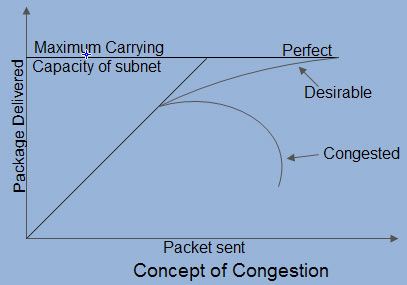
We’ll be covering the following topics in this tutorial:
Causing of Congestion:
The various causes of congestion in a subnet are:
• The input traffic rate exceeds the capacity of the output lines. If suddenly, a stream of packet start arriving on three or four input lines and all need the same output line. In this case, a queue will be built up. If there is insufficient memory to hold all the packets, the packet will be lost. Increasing the memory to unlimited size does not solve the problem. This is because, by the time packets reach front of the queue, they have already timed out (as they waited the queue). When timer goes off source transmits duplicate packet that are also added to the queue. Thus same packets are added again and again, increasing the load all the way to the destination. 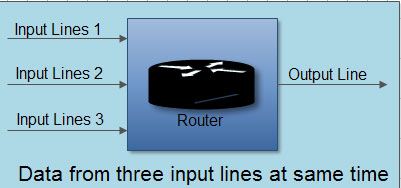
• The routers are too slow to perform bookkeeping tasks (queuing buffers, updating tables, etc.).
• The routers’ buffer is too limited.
• Congestion in a subnet can occur if the processors are slow. Slow speed CPU at routers will perform the routine tasks such as queuing buffers, updating table etc slowly. As a result of this, queues are built up even though there is excess line capacity.
• Congestion is also caused by slow links. This problem will be solved when high speed links are used. But it is not always the case. Sometimes increase in link bandwidth can further deteriorate the congestion problem as higher speed links may make the network more unbalanced.Congestion can make itself worse. If a route!” does not have free buffers, it start ignoring/discarding the newly arriving packets. When these packets are discarded, the sender may retransmit them after the timer goes off. Such packets are transmitted by the sender again and again until the source gets the acknowledgement of these packets. Therefore multiple transmissions of packets will force the congestion to take place at the sending end.
How to correct the Congestion Problem:
Congestion Control refers to techniques and mechanisms that can either prevent congestion, before it happens, or remove congestion, after it has happened. Congestion control mechanisms are divided into two categories, one category prevents the congestion from happening and the other category removes congestion after it has taken place.
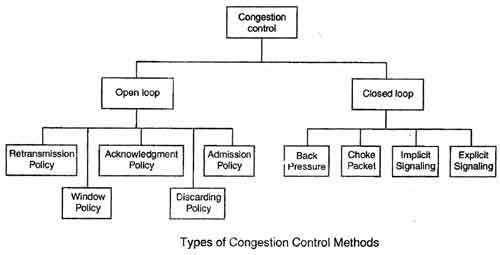
These two categories are:
1. Open loop
2. Closed loop
Open Loop Congestion Control
• In this method, policies are used to prevent the congestion before it happens.
• Congestion control is handled either by the source or by the destination.
• The various methods used for open loop congestion control are:
Retransmission Policy
• The sender retransmits a packet, if it feels that the packet it has sent is lost or corrupted.
• However retransmission in general may increase the congestion in the network. But we need to implement good retransmission policy to prevent congestion.
• The retransmission policy and the retransmission timers need to be designed to optimize efficiency and at the same time prevent the congestion.
Window Policy
• To implement window policy, selective reject window method is used for congestion control.
• Selective Reject method is preferred over Go-back-n window as in Go-back-n method, when timer for a packet times out, several packets are resent, although some may have arrived safely at the receiver. Thus, this duplication may make congestion worse.
• Selective reject method sends only the specific lost or damaged packets.
Acknowledgement Policy
• The acknowledgement policy imposed by the receiver may also affect congestion.
• If the receiver does not acknowledge every packet it receives it may slow down the sender and help prevent congestion.
• Acknowledgments also add to the traffic load on the network. Thus, by sending fewer acknowledgements we can reduce load on the network.
• To implement it, several approaches can be used:
1. A receiver may send an acknowledgement only if it has a packet to be sent.
2. A receiver may send an acknowledgement when a timer expires.
3. A receiver may also decide to acknowledge only N packets at a time.
Discarding Policy
• A router may discard less sensitive packets when congestion is likely to happen.
• Such a discarding policy may prevent congestion and at the same time may not harm the integrity of the transmission.
Admission Policy
• An admission policy, which is a quality-of-service mechanism, can also prevent congestion in virtual circuit networks.
• Switches in a flow first check the resource requirement of a flow before admitting it to the network.
• A router can deny establishing a virtual circuit connection if there is congestion in the “network or if there is a possibility of future congestion.
Closed Loop Congestion Control
• Closed loop congestion control mechanisms try to remove the congestion after it happens.
• The various methods used for closed loop congestion control are:
Backpressure
• Back pressure is a node-to-node congestion control that starts with a node and propagates, in the opposite direction of data flow.
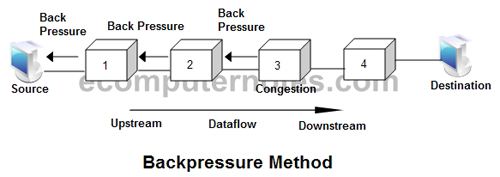 • The backpressure technique can be applied only to virtual circuit networks. In such virtual circuit each node knows the upstream node from which a data flow is coming.
• The backpressure technique can be applied only to virtual circuit networks. In such virtual circuit each node knows the upstream node from which a data flow is coming.
• In this method of congestion control, the congested node stops receiving data from the immediate upstream node or nodes.
• This may cause the upstream node on nodes to become congested, and they, in turn, reject data from their upstream node or nodes.
• As shown in fig node 3 is congested and it stops receiving packets and informs its upstream node 2 to slow down. Node 2 in turns may be congested and informs node 1 to slow down. Now node 1 may create congestion and informs the source node to slow down. In this way the congestion is alleviated. Thus, the pressure on node 3 is moved backward to the source to remove the congestion.
Choke Packet
• In this method of congestion control, congested router or node sends a special type of packet called choke packet to the source to inform it about the congestion.
• Here, congested node does not inform its upstream node about the congestion as in backpressure method.
• In choke packet method, congested node sends a warning directly to the source station i.e. the intermediate nodes through which the packet has traveled are not warned.

Implicit Signaling
• In implicit signaling, there is no communication between the congested node or nodes and the source.
• The source guesses that there is congestion somewhere in the network when it does not receive any acknowledgment. Therefore the delay in receiving an acknowledgment is interpreted as congestion in the network.
• On sensing this congestion, the source slows down.
• This type of congestion control policy is used by TCP.
Explicit Signaling
• In this method, the congested nodes explicitly send a signal to the source or destination to inform about the congestion.
• Explicit signaling is different from the choke packet method. In choke packed method, a separate packet is used for this purpose whereas in explicit signaling method, the signal is included in the packets that carry data .
• Explicit signaling can occur in either the forward direction or the backward direction .
• In backward signaling, a bit is set in a packet moving in the direction opposite to the congestion. This bit warns the source about the congestion and informs the source to slow down.
• In forward signaling, a bit is set in a packet moving in the direction of congestion. This bit warns the destination about the congestion. The receiver in this case uses policies such as slowing down the acknowledgements to remove the congestion.
Congestion control algorithms
Leaky Bucket Algorithm
• It is a traffic shaping mechanism that controls the amount and the rate of the traffic sent to the network.
• A leaky bucket algorithm shapes bursty traffic into fixed rate traffic by averaging the data rate.
• Imagine a bucket with a small hole at the bottom.
• The rate at which the water is poured into the bucket is not fixed and can vary but it leaks from the bucket at a constant rate. Thus (as long as water is present in bucket), the rate at which the water leaks does not depend on the rate at which the water is input to the bucket.
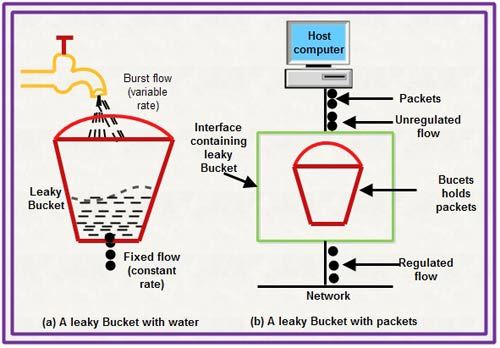 • Also, when the bucket is full, any additional water that enters into the bucket spills over the sides and is lost.
• Also, when the bucket is full, any additional water that enters into the bucket spills over the sides and is lost.
• The same concept can be applied to packets in the network. Consider that data is coming from the source at variable speeds. Suppose that a source sends data at 12 Mbps for 4 seconds. Then there is no data for 3 seconds. The source again transmits data at a rate of 10 Mbps for 2 seconds. Thus, in a time span of 9 seconds, 68 Mb data has been transmitted.
If a leaky bucket algorithm is used, the data flow will be 8 Mbps for 9 seconds. Thus constant flow is maintained.
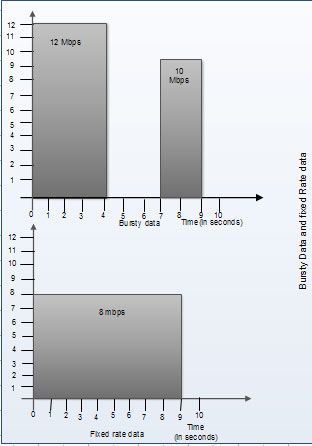
Token bucket Algorithm
• The leaky bucket algorithm allows only an average (constant) rate of data flow. Its major problem is that it cannot deal with bursty data.
• A leaky bucket algorithm does not consider the idle time of the host. For example, if the host was idle for 10 seconds and now it is willing to sent data at a very high speed for another 10 seconds, the total data transmission will be divided into 20 seconds and average data rate will be maintained. The host is having no advantage of sitting idle for 10 seconds.
• To overcome this problem, a token bucket algorithm is used. A token bucket algorithm allows bursty data transfers.
• A token bucket algorithm is a modification of leaky bucket in which leaky bucket contains tokens.
• In this algorithm, a token(s) are generated at every clock tick. For a packet to be transmitted, system must remove token(s) from the bucket.
• Thus, a token bucket algorithm allows idle hosts to accumulate credit for the future in form of tokens.
• For example, if a system generates 100 tokens in one clock tick and the host is idle for 100 ticks. The bucket will contain 10,000 tokens.
Now, if the host wants to send bursty data, it can consume all 10,000 tokens at once for sending 10,000 cells or bytes.
Thus a host can send bursty data as long as bucket is not empty.
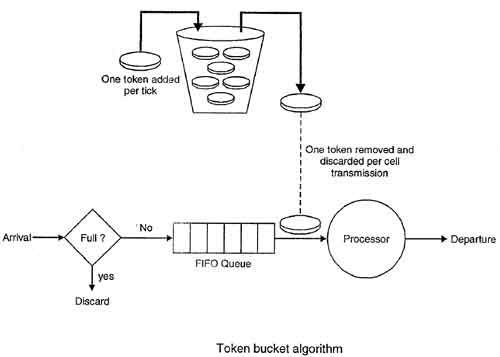
 Dinesh Thakur holds an B.C.A, MCDBA, MCSD certifications. Dinesh authors the hugely popular
Dinesh Thakur holds an B.C.A, MCDBA, MCSD certifications. Dinesh authors the hugely popular